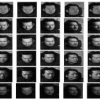Free Online Productivity Tools
i2Speak
i2Symbol
i2OCR
iTex2Img
iWeb2Print
iWeb2Shot
i2Type
iPdf2Split
iPdf2Merge
i2Bopomofo
i2Arabic
i2Style
i2Image
i2PDF
iLatex2Rtf
Sci2ools
ICCV
2001
IEEE
2001
IEEE
Lambertian Reflectance and Linear Subspaces
We prove that the set of all Lambertian reflectance functions (the mapping from surface normals to intensities) obtained with arbitrary distant light sources lies close to a 9D linear subspace. This implies that, in general, the set of images of a convex Lambertian object obtained under a wide variety of lighting conditions can be approximated accurately by a low-dimensional linear subspace, explaining prior empirical results. We also provide a simple analytic characterization of this linear space. We obtain these results by representing lighting using spherical harmonics and describing the effects of Lambertian materials as the analog of a convolution. These resultsallow ustoconstruct algorithmsforobjectrecognitionbasedonlinearmethods aswellasalgorithmsthatuseconvexoptimizationto enforce nonnegative lighting functions. We also show a simple way to enforce nonnegative lighting when the images of an object lie near a 4D linear space. We apply these algorithms to perform face recognition...
Computer Vision | Enforce Nonnegative Lighting | ICCV 2001 | Linear Space | Low-dimensional Linear Subspace | Nonnegative Lighting Functions | Simple Analytic Characterization |
| Added | 15 Oct 2009 |
| Updated | 31 Oct 2009 |
| Type | Conference |
| Year | 2001 |
| Where | ICCV |
| Authors | Ronen Basri, David W. Jacobs |
Comments (0)

